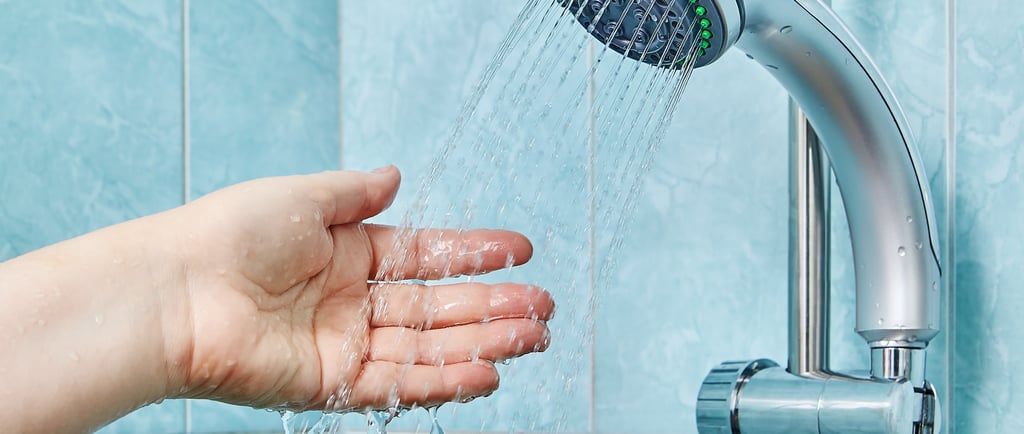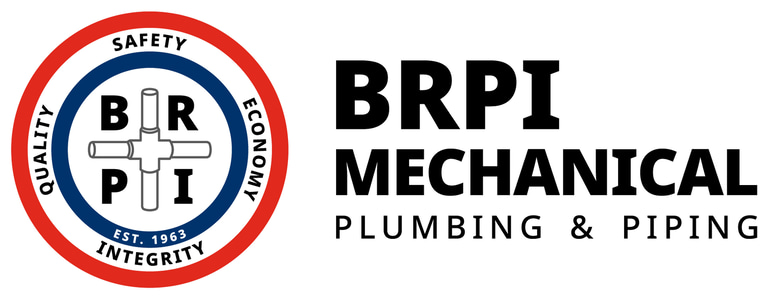From Drip to Rush: Understanding Water Pressure—And Why It Matters
FAQSRESIDENTIAL PLUMBINGCOST-SAVING PLUMBING TIPS
6/11/20255 min read


Let’s set the scene.
You’re groggy. It’s 6:48 a.m. You shuffle to the bathroom, turn on the shower, and get...a drizzle. Not a relaxing cascade. Not even a proper rinse. Just enough water pressure to make you wish you’d skipped that workout yesterday because raising your arms is work.
Or maybe it’s the opposite. You open a faucet, and it blasts water like it’s trying to knock over a small building. Your pipes groan. The kitchen sprayer jumps like it’s possessed. Somewhere in your home, you hear a weird banging noise. (Spoiler: it’s not a ghost—it’s water hammer.)
So what gives? Why is water pressure such a rollercoaster? And what’s the big deal if it’s just a little low…or high?
Let’s break it down—because understanding water pressure could save you real headaches, a ton of money, and maybe even your hardwood floors.
💦 First Things First: What Is Water Pressure?
Water pressure is exactly what it sounds like: the force that moves water through your plumbing system. It's measured in pounds per square inch (psi), and in a residential home, it’s typically somewhere between 40 and 80 psi. Too low, and you get showers that feel like a misting fan. Too high, and your pipes start acting like they’re training for a heavyweight title fight.
Water pressure is affected by gravity, elevation, municipal supply systems, and even the design of your own plumbing. In short: it’s a balancing act. A delicate one.
⚠️ Why Water Pressure Actually Matters (A Lot)
You might think water pressure is just about comfort. Showers, sprinklers, and dishwashers all work better with the right amount. But there’s more to it than convenience:
Low pressure can mean long fill times, poor appliance performance, and mysterious trickling faucets that never quite shut off.
High pressure might feel luxurious—until you realize it's secretly destroying your plumbing. Think pinhole leaks, damaged water heaters, blown-out fittings, and premature appliance failure.
In both cases, what starts as a pressure problem often ends as a repair bill.
🐢 The Lowdown on Low Pressure
Let’s talk trickles.
Low water pressure can turn basic tasks into patience drills. It can also be a sign of something more serious. Here are the usual suspects:
1. Clogged Pipes
If you live in an older home (hello, galvanized steel), mineral buildup inside your pipes could be narrowing the openings—think clogged arteries, but with water instead of blood.
2. Partially Closed Shutoff Valves
It happens more than you think. A main valve or fixture-specific valve isn’t all the way open, and your whole system pays the price.
3. Pressure Regulator Gone Rogue
Some homes have a pressure-reducing valve (PRV) that keeps incoming water from blasting your pipes. When a PRV fails, it can restrict flow—even if your city pressure is fine.
4. Municipal Supply Issues
Sometimes, it’s not you—it’s the city. Construction, leaks, or water main breaks can temporarily lower your incoming pressure.
5. Leaks (a.k.a. Sneaky Little Water Thieves)
A leak in your system doesn’t just waste water—it also means there’s less pressure available for your fixtures. Especially if it’s happening before the affected area.
Pro Tip: If you turn everything off and your water meter is still spinning, you probably have a leak. Time to call in a pro.
🚨 The Perils of High Pressure
If low pressure is annoying, high pressure is dangerous. It's like overinflating a balloon—you might get away with it for a while, but sooner or later, something’s going to pop.
1. Pipe Damage
Copper, PEX, CPVC—it doesn’t matter. No plumbing material is immune to long-term abuse from high pressure. Over time, it stresses the joints, fittings, and even the walls of the pipe.
2. Water Heater Mayhem
Your water heater has to handle both heat and pressure. High pressure can overwhelm its relief valve, reduce its lifespan, or cause it to fail catastrophically (and yes, that’s as bad as it sounds).
3. Appliance Wreckage
Washers, dishwashers, ice makers—all of them have internal valves and components that aren’t built for sustained pressure abuse. Say goodbye to warranties if they go kaboom due to psi overload.
4. Toilet Ghost Flushing & Faucet Drips
Ever hear your toilet refill when no one’s used it in hours? That’s not the plumbing version of The Sixth Sense. It’s high pressure messing with internal seals and valves.
🧪 How to Know If You Have a Pressure Problem
You don’t need to be a plumber to check your water pressure. Here’s how to play detective:
1. Buy a Pressure Gauge
You can find one at most hardware stores for under $20. It screws onto a hose bib (outside faucet) and tells you your system pressure.
Below 40 psi? Time to investigate low pressure.
Above 80 psi? You're officially in the danger zone.
2. Do the Bucket Test
For flow rate, place a gallon bucket under a faucet and time how long it takes to fill. Under 6 seconds? You’re good. Over 10? You may have pressure or flow restrictions.
3. Listen and Watch
Are your pipes banging when the washing machine shuts off? Does the shower scream like a banshee? Do faucets sputter or dribble weirdly? All signs of pressure irregularities.
🛠️ What You Can Do About It
The good news? Water pressure issues are fixable. Here’s how:
💧 For Low Pressure, Try This:
1. Clean Aerators and Showerheads
Sometimes it’s as simple as unscrewing the faucet aerator and cleaning out mineral gunk. Same goes for your showerhead.
2. Check and Open Valves
Ensure your main shutoff and fixture valves are fully open. Sounds obvious, but it’s a surprisingly common oversight.
3. Replace Failing PRVs
A worn-out pressure-reducing valve can choke your flow. A plumber can swap it out and dial it in for your home’s needs.
4. Repipe Old Systems
If your home has ancient galvanized pipes, low pressure might be your plumbing system’s cry for help. Repiping could restore normal flow—and prevent future leaks.
💧 For High Pressure, Try This:
1. Install a PRV (If You Don’t Have One)
This is your system’s bouncer. It steps in, checks IDs (pressure readings), and keeps the riff-raff (excess psi) out.
2. Add Expansion Tanks
Especially if you have a closed system with a water heater, an expansion tank helps absorb extra pressure from thermal expansion. It's a small device that makes a big difference.
3. Address Water Hammer
Water hammer arrestors can quiet your pipes and relieve pressure spikes. If your system clangs when valves shut off, this is your fix.
4. Annual Check-Ups
Just like you get your car inspected (hopefully), your plumbing should be checked periodically—especially in older homes or if you’ve noticed recent changes in performance.
🚀 Bonus Round: What About Pressure Boosters?
If your home consistently has low incoming pressure—even after fixes—a booster pump might be the solution. These devices increase your home’s water pressure to an ideal level.
They’re especially useful for these conditions:
Homes at the top of a hill
Multi-story buildings with low upper-floor flow
Areas with chronically low city water pressure
They’re not cheap, but they can solve a world of pain when properly installed and calibrated.
📜 Pressure and Building Codes: There Are Rules, Folks
Did you know that most local plumbing codes require water pressure to stay under a certain limit?
In Utah (and many other places), anything over 80 psi is a code violation. And if you’re over that and damage happens—say, your water heater bursts—insurance might not cover it.
Why? Because ignoring high pressure is like ignoring a dashboard warning light. It’s not a “maybe”—it’s a ticking time bomb.
⚖️ Okay, So What’s Normal?
Here’s the sweet spot:
Ideal Residential Pressure: 50–70 psi
Maximum Safe Pressure: 80 psi
Anything Over 80: Install a PRV—yesterday
Remember: more is not better. Balanced is better.
🧠 Final Thought: Pressure Is a Systemic Thing
The key takeaway? Water pressure isn't just about one annoying faucet or a weak shower. It’s a system-wide issue with ripple effects throughout your entire plumbing network.
When it’s too low, your appliances don’t work right, and you lose efficiency. When it’s too high, things wear out, break down, or burst—often with zero warning.
So whether you’re dealing with a feeble trickle or a pipe-rattling surge, don’t ignore it. Test your pressure, make adjustments, and keep your plumbing system balanced.
Because when it comes to water pressure, it’s not about more. It’s about right.
Contact
Main Office
Social
3560 S 2200 W
West Valley City, UT 84119
P.O. Box 25123
Salt Lake City, UT 84125
Monday – Friday:
7:00 am – 3:30 pm
Billing & Mailing Address
Hours
© Budd M. Rich Plumbing Company, DBA BRPI Mechanical. All rights reserved.
